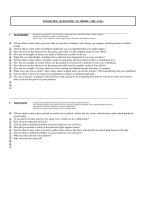Tài liệu Simple Tricks To Ace the Subnetting Portion of Any Certification Exam pdf
Bạn đang xem bản rút gọn của tài liệu. Xem và tải ngay bản đầy đủ của tài liệu tại đây (139.72 KB, 10 trang )
Simple Tricks To Ace
the Subnetting Portion
of Any Certification
Exam
1-800-COURSES
www.globalknowledge.com
Expert Reference Series of White Papers
Introduction
Subnetting seems to be a battle of fighting bits, decimal numbers, and countless methods and processes to
convert from one to the other. While the methods may be confusing, the mathematics behind them is the same
for all. In this paper, you will learn some of the simpler ways to figure out many of the subnetting questions
that you will find on the industry certification tests.
Unlik
e some of the more complex methods, these methods use subtraction,
addition, multiplication, and divi-
sion—no converting from binary or decimal. As a matter of fact, if you can do the four basic math functions,
you can learn these failure-free methods quickly and easily.
Warning: The basic assumption is that you are already familiar with subnetting and have actually learned
subnetting concepts elsewhere
. This white paper does not teach subnetting,
it teaches useful methods for
passing certification test questions.
Overview of Subnetting
The reason we subnet is to break larger IP networks into smaller ones. Often we have networks that are the
same size. These use a fixed length subnet mask for all networks. Other network designs employ different sub-
net masks, depending on the number of addresses required for each subnet. This is called variable length sub-
net masking or VLSM.
As I learned subnetting, I began to realize that subnetting is much like my grandmothers kitchen. When my
grandmother made pies, she cut the pies in various configurations depending on the needs of the pie eaters.
Often, the pie was cut with all pieces the same size. Other times she cut the slices in various sizes, depending
on who was eating. My grandfather always got the biggest piece . . . go figure.
In the end analysis, subnetting is taking a pie, your assigned address space, and cutting the address space into
variously sized pieces depending on need. My grandmother cut her pies with a knife. We cut our address space
by using subnet masks
.
By visually inspecting the pie my grandmother cut,
you could determine how big each
piece was. By looking at the address and subnet mask, you can see how many addresses are found in each
subnet and what those addresses are.
Let’s review some of the more important concepts related to subnetting.
Ted Rohling, Global Knowledge Instructor, CISSP
Simple Tricks To Ace the Subnetting
Portion of Any Certification Exam
Copyright ©2006 Global Knowledge T
raining LLC. All rights reserved.
Page 2
Address Class Identification
You will often need to identify the class of an IP address in order to complete test questions successfully.
Below is an address class table to assist you.
Address Class Table
The Octet and the Binary Progression
An octet is an eight bit data element. When IP was being developed, the term byte had two possible mean-
ings, a seven bit byte or an eight bit byte. The IP developers started using the term “octet” to reflect the eight
bit byte format. An eight bit data element has the ability to store the binary equivalent of decimal numbers
from 0 to 255.
Binary Table
The subnet mask and IP addressing revolve around the table shown above. This is the binary to decimal equiv
-
alent table. One of the first things you might consider doing in a certification test environment is to copy this
table from memory on to your scratch paper or erasable worksheet provided at the testing center.
Another table to record is below:
Mask Table
Copyright ©2006 Global Knowledge T
raining LLC. All rights reserved.
Page 3
Address Class First Octet Value Range First Octet Binary Value
A 0-127 0nnnnnnn
B 128-191 10nnnnnn
C 192-223 110nnnnnn
D 224-239 1111nnnn
2
7
2
6
2
5
2
4
2
3
2
2
2
1
2
0
128 64 32 16 8 4 2 1
Binary Mask Addr
esses
00000000 0 256
10000000 128 128
11000000 192 64
11100000 224 32
11110000 240 16
11111000 248 8
11111100 252 4
11111110 254 2
11111111 255 1
T
his table contains the eight possible octet values for any mask along with the decimal equivalent. It will be
used to determine the mask when the number of subnets required is given.
Mask-to-Prefix or Prefix-to-Mask Conversion
255.255.255.0 is equivalent to a prefix of /24.
If you see masks or prefixes on your exam, don’t panic. The prefix is simply another way to state the mask. The
prefix contains a count of the total number of 1 bits in the subnet mask. The conversion is quite simple. You
can use the mask table above to help determine the number of bits in each octet of the mask.
To convert from mask to prefix: simply add together the number of bits found in the mask. For example,
the mask 255.255.248.0 is equivalent to a /21 bit prefix. Here’s how the conversion is done.
255 = 8 bits
255 = 8 bits
248 = 5 bits
0 = 0 bits
The sum of 8 + 8 + 5 + 0 is 21.
Here’
s another example:
What is the prefix when the mask is 255.255.255.192?
255 = 8 bits
255 = 8 bits
255 = 8 bits
192 = 2 bits
The sum of 8 + 8 + 8 + 2 is 26. The correct answer would be /26.
To convert from prefix to mask: rather than add, you will subtract.
In this example, you are asked to convert the mask prefix /23 to a mask. Here’s how it is done.
Begin by subtracting 8 from the prefix number. 23 – 8 = 15 255.
T
hen subtract another 8 from the remainder
15 – 8 = 7
255.255.
Find the seven bit entry in the mask table and add it to the mask 255.255.254.
Since there are no bits left, add 0 to the mask 255.255.254.0
The answer is 255.255.254.0
Another w
ay to arrive at the same solution is to tak
e the prefix and divide it by 8.
23 / 8 = 2 with a remainder of 7.
Copyright ©2006 Global Knowledge T
raining LLC. All rights reserved.
Page 4
T
here are two 255s in the front of the mask with seven additional bits in the third octet and no bits in the
fourth. 255.255.254.0
I prefer the remainder method. Here’s another example.
Convert /29 to a subnet mask.
29 / 8 = 3 with a remainder of 5
There are three 255s in the mask with a five bit fourth octet. 255.255.255.248
What Mask To Use, Part 1
One of the problem classes used in certification tests is the “what mask” class. You are given a description of
a networking situation and are asked to select the correct mask to use in subnetting the network.
Here is a typical question:
XYZ Corporation is using the 192.168.100.0 private address to implement a workgroups in their network. Each
workgroup will consist of 17 devices requiring IP addresses. One additional address is required for the router
interface in each subnet. What subnet mask should XYZ use?
First, determine the number of addresses in each subnet; in this case, 18. Next, round up to the next power of
2. The next larger power of 2 beyond 18 is 32.
Subtract 32 from 256. The result is 224. This is the fourth octet
of the mask to complete this subnetting problem: 255.255.255.224
This method works with Class C addresses where the number of required addresses is known. It can also be
extended to any addressing situation where the number of addresses in each subnet is known.
Another example:
XYZ Corporation is using 172.16.0.0 for their networking needs. Each subnet requires 280 IP addresses includ-
ing the router interface. What subnet mask should be used?
For IP addressing requirement where the number of addresses is greater than 256, divide the number of
addresses by 256.
280 divided by 256 is 1 with a remainder of 26. If there is a remainder, add 1 to the quo-
tient. Our operational number is now 2. As we did before, subtract 2 from 256. The result is 254 which is the
third octet of the subnet mask for this problem;
255.255.254.0.
What Mask To Use, Part 2
In the two previous examples, we were given the number of addresses required in each subnet. What if the
question provides the number of subnets required? Here’s a method to solve those problems.
XYZ Corporation is using the 192.168.100.0 priv
ate address to implement a workgroups in their network.
T
here will be 5 subnets implemented.
What subnet mask should XYZ use?
Copyright ©2006 Global Knowledge T
raining LLC. All rights reserved.
Page 5









